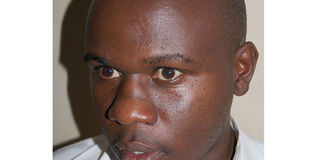Man with rare eye condition seeks help

Rogers Kabaale speaking during the interview. He requires about Shs25m for a corneal transplant in Nairobi, Kenya. Photo by Denis Edema
Rogers Ssemmanda Kabaale was studying for a Bachelor’s degree in Mechanical Engineering at Makerere University, when he was forced to drop out due to an eye condition known as keratoconnus.
According to Wilson Bagonza a medical clinical officer at Vision Care Opticians in Kampala, keratoconnus is an eye disease that affects the structure of the cornea. The cornea is responsible for refracting light rays entering the eye onto the lens which refocuses it to the retina. However, when it is in distorted shape, the cornea does not perform this function well.
How it all started
Kabaale says his predicament started when he was in primary school. “I never sat beyond the second row in class since I could not easily read what was on the blackboard. I could turn to my neighbours to see what they had written,” he recalls.
With his eyesight slowly waning, Kabaale pressed on through secondary school by doing research on his own and using notes from his classmates.
And amid this struggle, he was able to pass his exams and join Makerere University.
However, he did not advance beyond his second year. “Everything was blurry. I never got a single retake in first year but in second year, I got eight retakes,” Kabaale states.
He adds, “I endeavoured to attend lectures but all in vain because I had to look at my classmates’ notes and the workload was much more than it was in secondary school.”
In his first year at Makerere University in 2001, Kabaale finally went for an eye check-up at Mulago and Mengo hospitals, but he could not afford the Shs400,000 that he needed to pay for contact lenses.
“The lenses were costly but they did not help much. There was very little difference when I wore them,” he says. Generally, patients with keratoconnus usually raise complaints of deteriorating vision, first occurring in one eye, before affecting the second one. “One might also have multiple images of a single object,” says Bagonza. According to him, keratoconnus cannot be treated in Uganda but in neighboring countries such as Kenya and Rwanda. Over the years, Kabaale has made attempts to resume his studies at the University to no avail. However, in 2011 using his savings, he underwent collagen cross-linking treatment in the right eye in Nairobi.
This type of treatment involves using eye drops of Vitamin B12, special ultra violet light to strengthen the collagen fibers of the eye hence strengthening the cornea. When this kind of treatment is administered, then the keratoconnus stops progressing. In Kabaale’s case though, the treatment was not helpful because his condition had advanced.
Corneal transplant
“My last resort now is to go for a corneal transplant in Nairobi,” explains Kabaale.
The corneal transplant required involves replacing Kabaale’s cornea with a cornea from a donor. “While in Nairobi, I was informed that a good cornea costs $5000(about Shs12m),” says Kabaale.
In addition to this cost, Kabaale will need to undergo approximately two months of recovery in Nairobi bringing the total amount of money he needs to $10,000 or Shs25m.
At the moment Kabaale spends his time designing still graphics, but says his customers are losing trust in him because of mistakes he makes.
Bagonza says, “If Kabaale does not get this operation, he will go totally blind.”
To help Rogers Ssemmanda Kabaale, you can reach him on 0705032242




